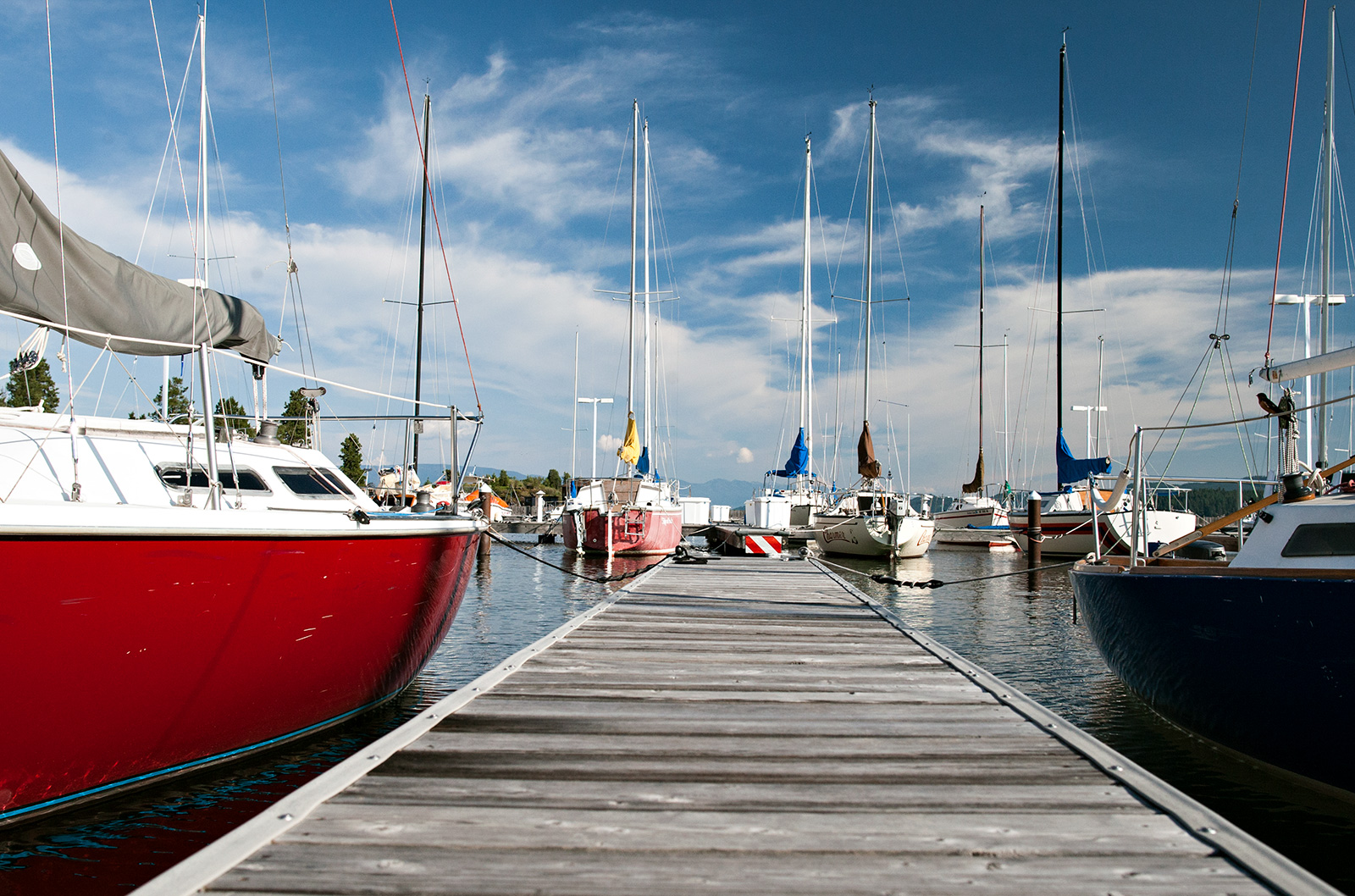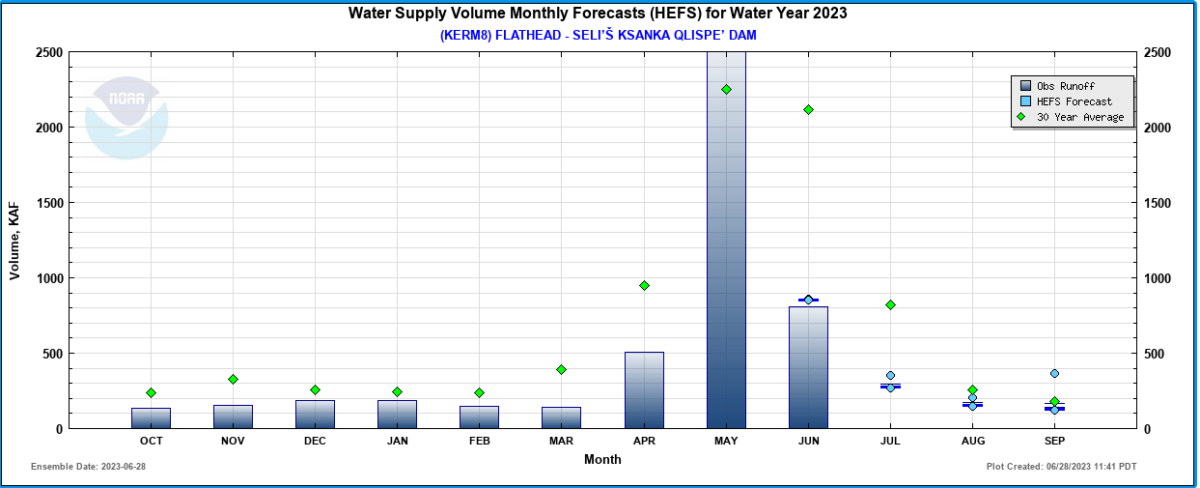As Flathead Lake Level Hits Record Low, Concerns Rise Up for Boat and Business Owners
Below-average precipitation in northwest Montana has already depleted stream inflows and dam operators predict water levels will keep dropping
By Micah Drew
Historically low water surface levels on Flathead Lake are already giving rise to concerns in northwest Montana, where a below-average winter snowpack thawed out early and has led to depleted stream inflows.
Boaters and business owners on Flathead Lake say the historic low lake levels are already presenting problems, and they worry that if the trend continues the summer boating season could dry up early.
On June 28, the water level on Flathead Lake had reached an all-time low for this time of year, according to U.S. Geological Survey data, with surface water levels reaching 2,892.1 feet, or 9 inches below the dam-controlled lake’s full-pool mark and a foot below the 23-year median.
Meanwhile, streamflow volumes are projected to run at more than 60% below average through July, causing the lake level to drop to 22 inches below full pool by July 12, according to forecasts.
“The facts are what the facts are. People need to realize this is going to happen and there’s no relief in sight, barring a great rainstorm, but there’s none in the forecast,” said Brian Lipscomb, CEO of Energy Keepers, Inc., the corporation that operates the Se̓liš Ksanka Qĺispe̓ (SKQ) Dam and controls the output from Flathead Lake. “There’s just not a lot of water in the northwest right now and there will be cascading effects from lower energy generation to recreational impacts.”
Waterways throughout the Columbia River Basin are collectively managed through a series of 60 major dams, including the SKQ Dam and Hungry Horse Dam. They regulate flood control, energy generation and irrigation, as well as streamflow for fish migration and recreation. As of Wednesday, Hungry Horse Reservoir was sitting roughly 6 feet below full pool.

According to Lipscomb, the Energy Keepers refilled Flathead Lake per the SKQ Dam’s operating requirements by aggressively capturing the spring runoff during the first weeks of May, when the region’s below-average snowpack melted out at the fastest rate seen in 30 years. Beginning June 3, SKQ operators decreased lake outflow to the lower Flathead River to the minimum streamflow and will continue to operate at minimum allowable levels until the lake level stabilizes, Lipscomb said. The minimum outflow levels are determined by the Federal Energy Regulatory Commission (FERC) and based on flood risk management, power generation requirements and biological needs to support aquatic life, particularly native trout populations. Beginning July 1, the minimum streamflow below the dam will drop from 12,700 cubic feet per second (cfs) to 6,400 cfs, in 420 cfs per day increments, according to the dam’s FERC license.
The Middle and North forks of the Flathead River are free-flowing, meaning there are no dam controls so the amount of water in the rivers is dependent on the snowpack. The South Fork Flathead River is controlled by Hungry Horse Dam.

Flathead Lake reached a peak pool level of 2,892.76 feet by June 12 , but has since declined due to record low streamflow levels throughout northwest Montana. In the Columbia Falls area, the USGS Flathead River stream gauge measured just 4.84 feet on Wednesday afternoon, the lowest level measured on June 28 since the federal agency began tracking gauge height in 2007. Most of Flathead County is currently classified under moderate or severe drought conditions.
“This is happening right now, and it’s happening very rapidly so people need to prepare themselves appropriately,” Lipscomb said, adding that recreation on the lake is going to be “unlike anything in the past.”
The current 9-inch drop from full pool is already causing concern for marina owners.
In Lakeside, Flathead Harbor owner Joel Eddins says he could be looking at a six-figure drop in revenue if the lake level doesn’t stabilize.
“I’ve got boats that are already about to start hitting metal pylons and will need to be pulled out,” he said. “If it goes down another 12 inches, the lifts are useless, my fuel dock will be limited to just pontoons — no sailboats or power boats will be able to use it.”
“We already have such a short season to operate in,” Eddins continued. “If I have to start pulling boats in the next week… I’m seeing my season get destroyed.”

On the north end of the lake, North Flathead Yacht Club (NFYC) Commodore Ashli Slawter is having similar conversations with members. If the levels continue to drop, Slawter said the Somers Bay marina won’t be able to accommodate the largest sailboats, leaving owners with the choice to either pull their boats for the season, or hope they can find another location that will be deep enough for extraction later in the summer.
“If the lake drops one more foot, we’ll be in a pickle,” Slawter said. “This is absolutely going to affect the sailing community.”
The NFYC will be hosting the 77th annual Thistle National Championships from July 16-21, with 90 boats expected to arrive from around the country. Thistles are small, high-performance racing sailboats that are 17-feet long, and Slawter said while the regatta isn’t in jeopardy from low water levels, it would be challenging to clear the marina slips of sailboats if members must pull them for the summer.
“The biggest issue around the lake is going to be getting boats out of the water,” Slawter said. “It’s going to end the sailing season for a lot of our members.”

The outlook for the next month looks bleak to Lipscomb, the Energy Keepers CEO who said the latest data indicates Flathead Lake is forecast to drop to a full 22 inches below full pool, barring significant weather events. It’s possible that projection will continue to drop — streamflow forecasts for June and July have declined 30% since May and Lipscomb expects they will continue to drop. He also expects this to become a more regular occurrence in the future.
“We can point directly to climate change, and the scary part about this is it’s just the tip of the iceberg,” he said. “Climatologists have forecasted that it will get much worse before things will get better. We’re going to see much hotter and drier and much colder and wetter seasons — both extremes going forward.”
Last year, Flathead Lake experienced the other end of the spectrum as the lake naturally overfilled, and similar oscillations will continue to get more extreme, Lipscomb said. Without such big deviations from historic averages, the Energy Keepers will have to “just stay on it and make adjustments quicker” in future operations.
“There’s not much that can be done to curtail the situation,” Lipscomb said.
“This is Mother Nature right now, in the midst of the climate change world.”